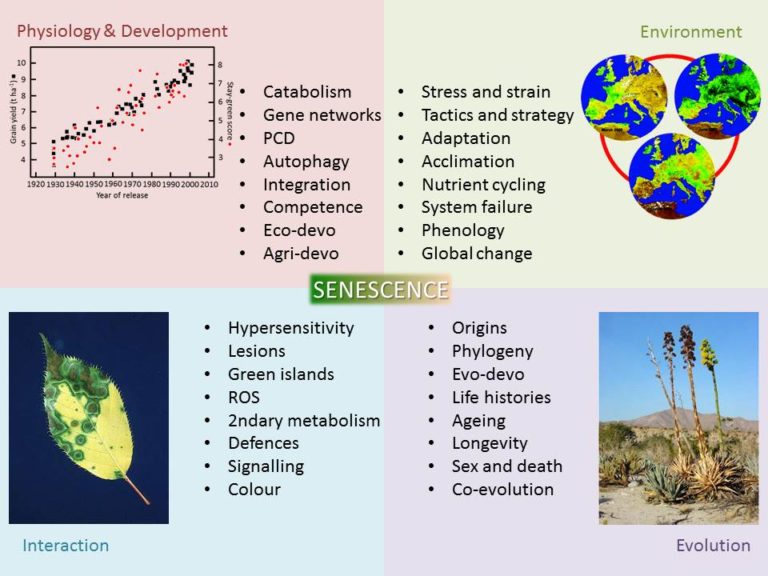Senescence Catechism
How does senescence enable plants to survive in a testing environment?
- Senescence is a terminal developmental event that usually, but not invariably, results in the death of the plant or its parts
- Stress (non-optimal environment) is a way of life for plants and selective senescence is one of the main ways they deal with it
- Senescence is a pervasive biological process that dominates many ecosystems and, as satellite imaging shows, can be seen from space
- Autumnal senescence of temperate forests is an example of senescence deployed strategically to deal with regularly recurring stresses
- Senescence is often a tactical response to unscheduled challenges such as unseasonal drought
- Internal nutrient recycling during senescence attunes individuals and communities to the nutritional status of the soil environment
- Physiological collapse, where stress exceeds adaptive and acclimatory capacities, is a failure, rather than a result, of senescence
- Senescence in the life-cycle is a critical phenological metric and a sensitive indicator of biosphere response to global change
How and why did senescence arise in plant evolution?
- Senescence is an assemblage of processes that arose at different times in evolution
- The origins of the components of the senescence syndrome can be reconstructed by phylogenetic analyses
- Molecular studies of phylogenetic distribution show carotenoid and chlorophyll metabolism in senescence to be evolutionarily ancient
- Building senescence into the developmental repertoire has contributed to the diversification of structures, functions and lifeforms
- The physiologies of senescing leaves, ripening fruits and developing floral organs are variations on a common theme
- To understand plant life-cycles and ecophysiologies, we need insights into the relationship of senescence to ageing
- Organisms that reproduce once and die are termed semelparous; monocarpic plants are semelparous
- Iteroparous organisms reproduce repeatedly throughout their lifespan; polycarpic perennial plants are iteroparous
- Plants represent a unique perspective on the central biological question of how reproduction and senescence are related
- Monocarpic species exemplify the concept of death as the price paid for sex but polycarps do not conform to this principle
- The nature of ageing in plants is a challenge to models of biological ageing coming out of gerontology and medical sciences
What part does senescence play in a plant’s relations with other living organisms?
- The nature and expression of senescence in plants are outcomes of coevolutionary influences from biotic factors in the environment
- Pathogens commonly invoke senescence-like hypersensitive, chlorotic and necrotic responses in their hosts
- Green islands often form when a pathogen attempts to turn senescing host tissue into a zombified source of nutrition
- Biotic and abiotic interactions have driven the evolution of distinctive senescence-specific metabolism
- Reactive oxygen species and secondary pathways are common to senescence physiology and defences against pathogens and predators
- The characteristic yellows, oranges, reds and purples that often develop during senescence are symptoms of novel metabolism
- The molecular basis and function of some colour changes in senescence are well established: e.g. de-greening and chlorophyll breakdown
- Because intermediates are photosensitizers, chlorophyll catabolism takes place via a kind of detoxification pathway
- Controlled removal of chlorophyll during senescence makes chloroplast thylakoid proteins available for recycling
- The significance of changes in carotenoid and phenylpropanoid pigments in senescing leaves is incompletely understood
- Some hypotheses propose that the reds and yellows of senescing leaves are visual signals to interacting insects
- There is evidence that colour changes protect senescing tissue from damage by light or other abiotic stresses
- It is possible that the colours of senescing tissues invite aesthetic responses in humans but have no intrinsic function
What goes on inside a senescing plant, and how does it help to know?
- As well as chlorophyll catabolism, pathways for remobilization and salvage of nutrients (N,P,S) are activated during senescence
- There have been significant recent advances in knowledge of the cell biology of protein recycling in senescing tissues
- Details of nucleic acid, lipid and other metabolic pathways during senescence remain to be determined
- Vast numbers of senescence-associated genes and regulatory elements have been described
- Efforts to build senescence-associated genes into meaningful regulatory networks are at an early stage
- Plant senescence is often classified as a member of the programmed cell death family of terminal processes
- The relationship between senescence and other instances of programmed autolysis, such as autophagy, is a fertile research area
- At the level of whole-plant development, senescence is integral to the regulatory cross-talk between sources and sinks
- Plants and their parts must achieve competence before they can senesce in response to internal and environmental signals
- Competence to senesce is associated with phase-change, the juvenility-maturity transition, and epigenetic factors
- Plant development is not only origami (morphogenesis and growth); it requires scissors (selective deletion through senescence) too
- Senescence is an essential element in eco-Devo, genotype-phenotype studies of functioning individuals and evolving plant populations
- By analogy with eco-Devo, senescence is critical for Agri-Devo, the study of crop development, yield and survival
- Senescence is a primary target for economically and environmentally expensive agricultural inputs (fertilizer, pesticides, water)
- Senescence sets limits on crop adaptability and resource capture
- Agriculture is largely concerned with keeping crops alive long enough and in a physiological condition to yield a harvest
- Many modern staples have been selected for delayed senescence (stay-green) and efficient nutrient recycling
- Understanding how and why plants senesce is necessary if we are to address global ecological and agricultural challenges
